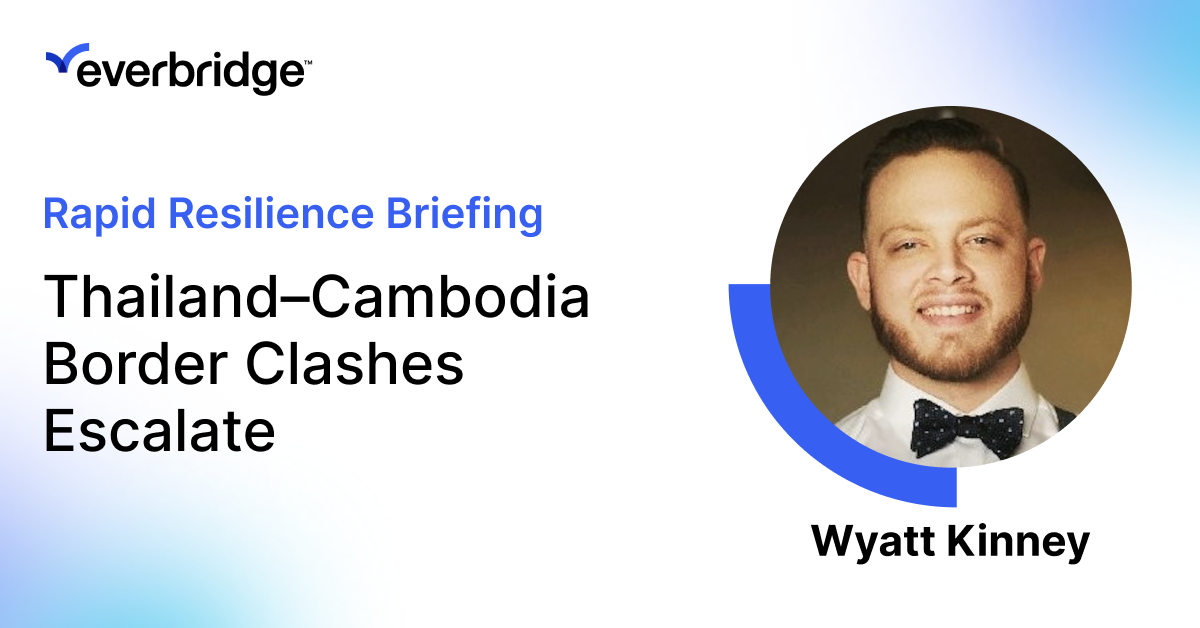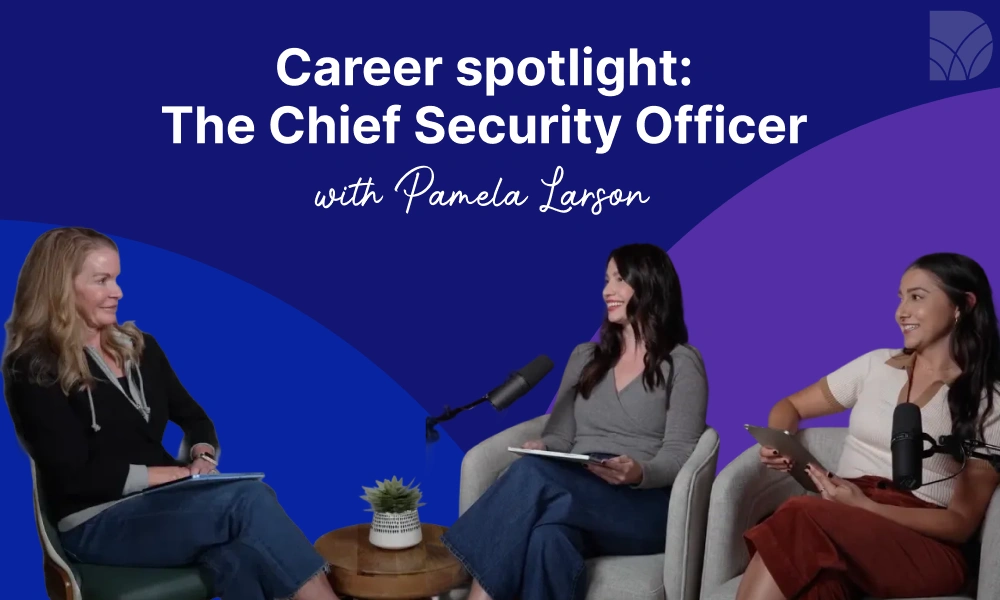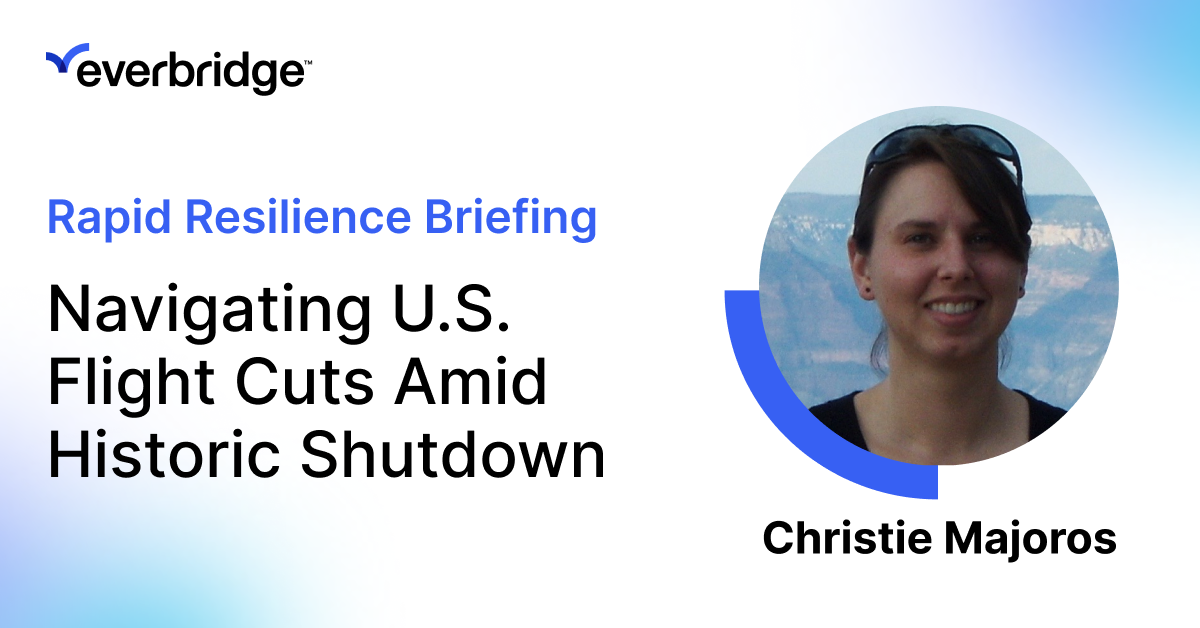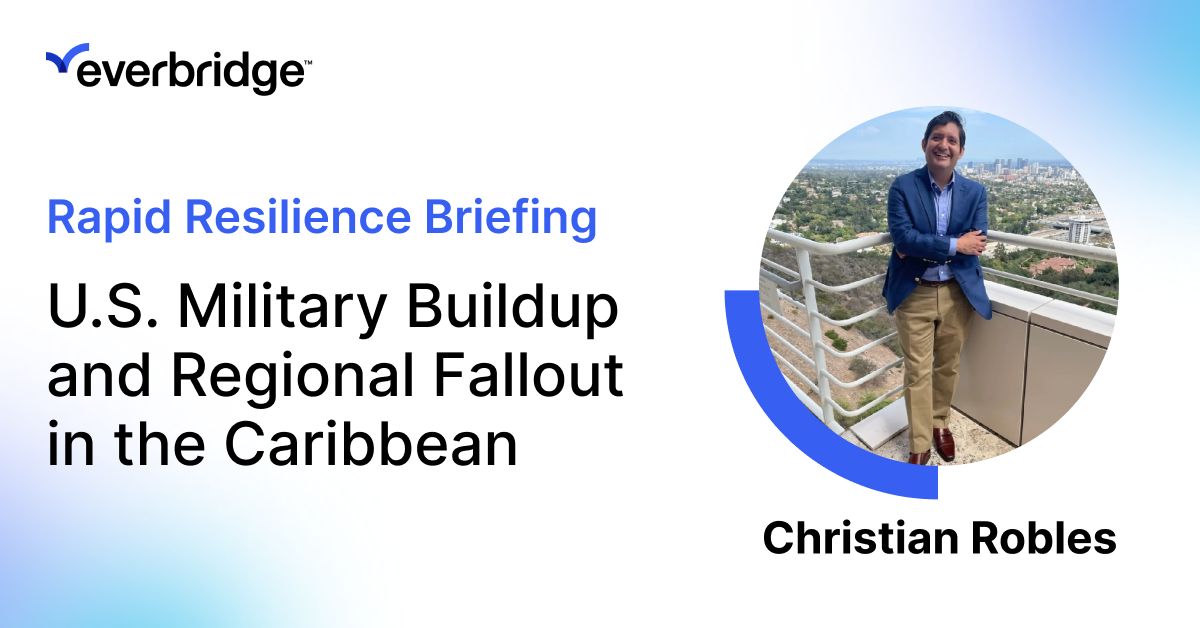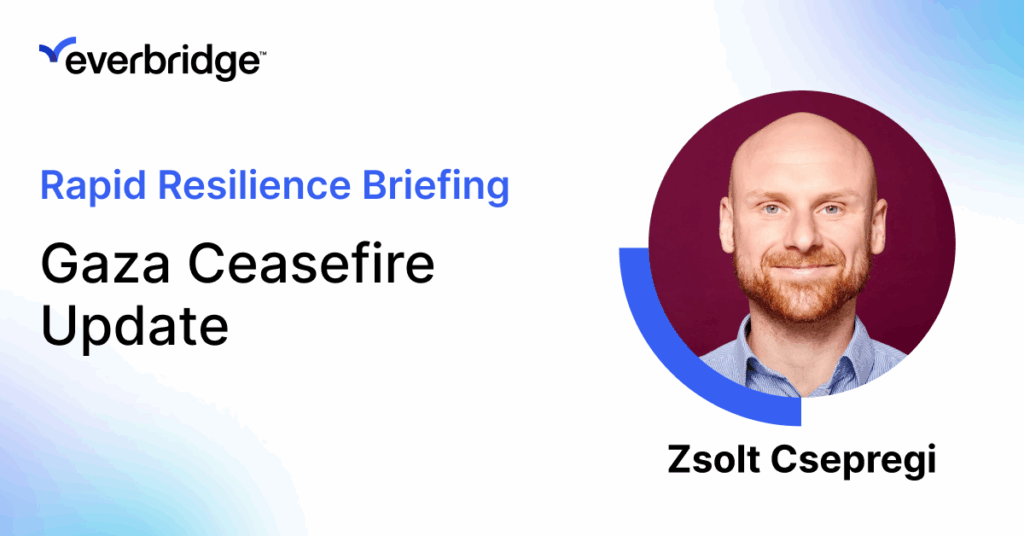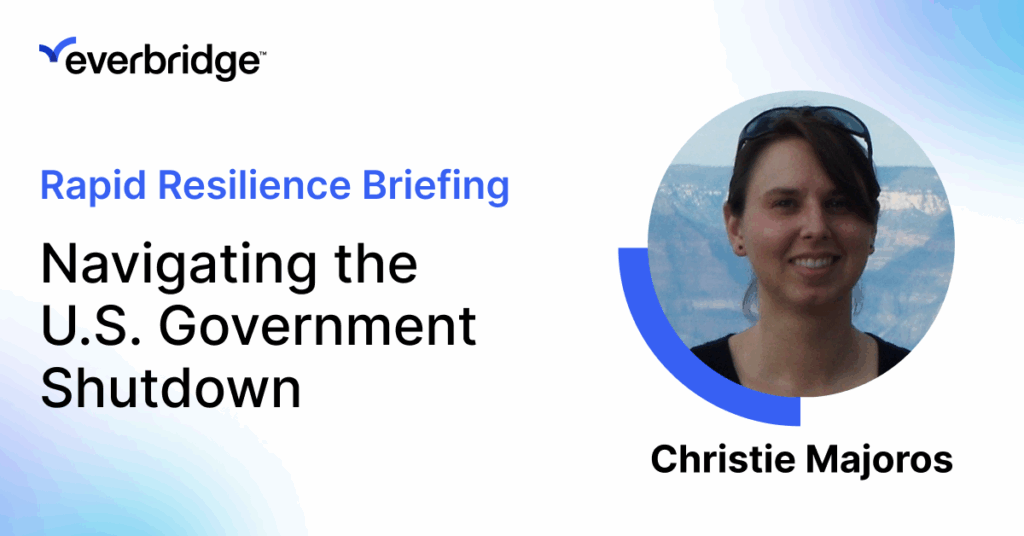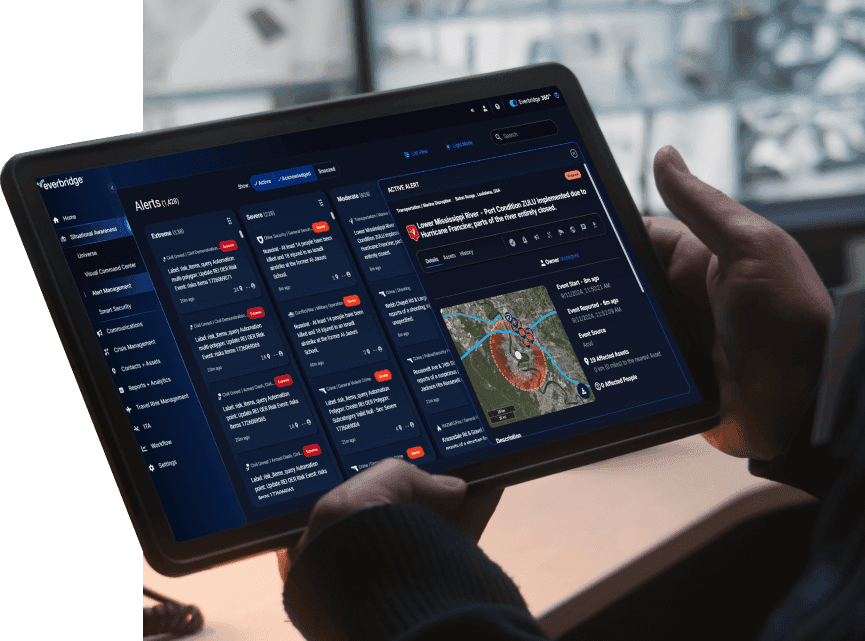Full transcript
[00:04.9]
Hello, my name is Wyatt Kinney and I’m the Everbridge Global Insights team’s regional analyst for Asia Pacific. Today I’ll be providing a brief update on renewed military tensions along the Thailand and Cambodian border and what this escalation means for organizations operating in the region.
[00:21.3]
On December 8th Thailand carried out airstrikes against Cambodian military positions near the contested areas of Pre Vaheer and Tamu. And Tom, Thai authorities say the strikes were a defensive response after Cambodia deployed long range rocket systems close enough to threaten Thailand civilian areas.
[00:39.5]
Cambodia reports at least four civilian deaths, additional injuries and damage to infrastructure in the area that was impacted. Both governments initiated evacuations along the border following the strikes. This marks the most serious escalation between the two countries south since mid-2025.
[00:57.0]
Why does this matter? These strikes are part of a broader pattern of instability throughout 2025, including exchanges of fire between the two sides earlier this year in May, civilian confrontations in September along the border which included protests and a landmine blast in November that disrupted the Kuala Lumpur Peace Accord which was a US and Malaysia facilitated framework designed to help Thailand and Cambodia manage border incidents, coordinate troop movements, support joint de mining within the area.
[01:27.3]
The implementation of this peace report has been uneven as we’ve seen further escalations since it’s been implemented. At the same time the communication channels meant to prevent escalation are underdeveloped or inconsistent. Without reliable joint investigation or de escalation tactics, even routine troop movements from either side can be seen as hostile actions.
[01:51.3]
So the core of what drives the tension between the two countries, the International Court of Justice in 1962 ruled that the pre of a year of temple belongs to Cambodia. But the ruling did not clarify the surrounding territory, leaving the border ambiguous and highly dispute prone.
[02:10.8]
Domestic politics play a role as well. Thai security institutions emphasize rapid decisive responses. Cambodia faces a strong sovereignty expectation from communities living near the contested area. External actors also shape the tension.
[02:27.7]
The US and Malaysia continue to support the Kuala Lumpur process in the peace accord. Cambodia’s close relationship with China adds additional geopolitical weight to its own decision making when these disputes occur. So impacts on business operations.
[02:45.2]
For companies operating in northeastern Thailand or northwestern Cambodia, this escalation affects logistics, workforce mobility, regulatory processes and project timelines. Cross border checkpoints already seeing slower processing and heightened inspections.
[03:02.0]
Manufacturing zones reliant on cross border flows including textiles, footwear, electrical components, automotive components. It’s possible they’ll see production delays and the need for higher inventory buffers, Cambodian nationals working in Thailand may face tighter document checks, leading to temporary workforce gaps.
[03:22.1]
Infrastructure and development projects near the border, especially those requiring surveys or demining, may experience pauses or restricted access. Even administrative processes such as Cambodia’s recent e visa changes are adding uncertainty to the digital and regulatory workflows.
[03:40.5]
So, an outlook for this situation in the next 48 to 72 hours. Continued tension along the border, no doubt. Hopefully no indication of intentional escalation. But like we talked about before, you know, even a simple troop movement could spark something. The lack of joint monitoring keeps misinterpretation risks elevated.
[04:00.8]
Certainly, over the next two to six weeks, fragile standoff is most the most likely scenario. Even with occasional incidents, uneven diplomatic engagement, organizations should anticipate recurring operational variability, over the next six to 12 months going into 2026, the core issues are going to remain, which includes an unclear border, leftover mines, and weak coordination between the two governments.
[04:32.4]
Unlikely, to be resolved, be resolved quickly. Because of that, even without a full scale conflict, the border is expected to remain unstable from time to time or sporadically throughout the next year. So what should organizations do now?
[04:47.5]
Companies should ensure their business continuity plans allow rapid adjustments to routing, staffing, and facility access. Alternate transport corridors either through Laos, Vietnam, or other maritime routes may be needed if tensions increase. Non essential travel near affected districts should be limited.
[05:05.3]
Essential personnel should receive vetted route guidance and reliable communication tools. And finally, communication with staff, partners, and investors should remain factual and neutral, Given the sensitivity of the territorial issues. Thank you so much.
[05:20.6]
We’ll continue to monitor the situation closely. Have a great rest of your day.
Full transcript
00:05
Hello, my name is Christian Robles and I’m the regional analyst for Latin America in the Caribbean here at Everbridge. We’ve been following this story since mid August when reports first surfaced that the US was deploying naval and air assets into the southern Caribbean.5sAdd a noteJump to
00:22
Early positioning framed as a counter narcotics buildup against so-called narot terrorists in the region. Two months later, that buildup has become a live operation. The US has now conducted 10 confirmed strikes. Eight in the Caribbean Sea and two in the Eastern
00:40
Pacific, killing at least 43 people and capturing two others. The latest strike hit a Drenad Aagua vessel in international waters. And hours later, Washington ordered the deployment of the Gerald R. Ford carrier strike group into the region under US southern command.
01:02
This marks a turning point. What began as targeted interdictions is now a full-scale power projection in the Western Hemisphere. And looking ahead, if this continues, several outcomes are possible. First, the operation could expand beyond the sea. President Trump has said he
01:22
won’t seek a declaration of war and that land operations will be next. That raises the prospect of covert actions inside Venezuela or air strikes on inland targets. Redrawing the map of US engagement in South America. Second, regional alignment is hardening. Colombia accuses Washington of
01:45
extrajudicial killings while Venezuela is mobilizing forces along its borders and warning of asymmetrical warfare. Meanwhile, Trinidad and Tobago is moving the other direction, hosting the destroyer USS Graveley and 2,000 Marines this week for joint exercises. The
02:05
island has become Washington’s southern anchor, a forward partner now facing greater exposure to Venezuelan cyber and intelligence pressures. And third, the commercial impact for shipping energy and insurance. The southern Caribbean is shifting from a patrol zone to a contested operating environment.
02:29
It’s expected temporary port closures in Trinidad and Tobago, higher war risk and detention premiums within 200 nautical miles of Venezuelan waters and strict sanctions screenings as the US expands terror designations. If exclusion zones appear or if Venezuela begins shadowing commercial
02:49
traffic, markets will react quickly. Since August, this campaign has evolved from deterrence to execution. The language deployments and now the carrier group all signal a sustained operational phase. If the tempo continues, the next step could move Finland. A shift that would
03:09
rattle regional stability and the confidence of US companies moving goods, fuel or data through these routes. We’ve been covering this from all angles and the takeaway is clear. We recommend monitoring unfolding events. Each new strike, asset movement signals that this
03:30
operation isn’t slowing, and the longer it runs, the harder it becomes to unwind. I’m Christian Robas, and we’ll continue tracking how these developments shape risk and stability across the region in the days ahead.
In our latest Rapid Resilience Briefing, we analyze the new phase-one Gaza ceasefire, a fragile starting point but not a complete peace plan.
Full transcript
[[00:05.0]
Hello, my name is Zsolt Csepregi. I’m the regional, analyst for the Middle east and North Africa at Eberbridge’s Global Insights Team. Today I will outline the ceasefire deal between Israel and Hamas and highlight the associated security and business risks. The newly announced Gaza ceasefire, which was brokered by the United States, Egypt, Turkey and Qatar, is a phase one agreement which is designed to secure the release of Israeli hostages in exchange for Palestinian prisoners, assured limited withdrawal of Israeli forces from Gaza and expanded humanitarian aid access.
[00:39.4]
It’s an important step, but it’s not a solution. Mediators themselves call it a starting point. A narrow humanitarian and political transaction, but not a complete peace plan. The goal right now is simple, to stop the immediate fighting and get the Israeli hostages home.
[00:55.9]
Everything beyond that, from Hamas disarmament to the future of Gaza’s governance, remains deeply contested. The second phase, meant to turn this truce into a sustainable political settlement, will be much harder. Israel insists that Hamas must be disarmed and excluded from the governance of Gaza.
[01:14.9]
While Hamas for its part, refuses to surrender control or its legitimacy. These positions are fundamentally incompatible once the immediate pressure eases. So the Israeli hostages are home and Israeli troops pull back, both sides will have far less incentive to compromise.
[01:34.7]
External actors are also shaping this trajectory. Palestinian Islamic Jihad has cautiously accepted the deal, but there is still a risk that more militant elements within Hamas or BIG could splinter towards Islamic State aligned, groups that outrightly reject any form of political compromise with Israel.
[01:55.6]
The Houthis in Yemen continue to reject the ceasefire outright, keeping Red Sea maritime risks elevated, while Hezbollah remains deliberately ambiguous along the northern border of Israel. For businesses and international operators, this environment represents de escalation without guaranteeing a resolution.
[02:15.4]
It’s a reduction in immediate violence, but not in underlying instability. So logistics and air travel are likely to remain volatile with potential disruptions from renewed rocket fire, drone attacks or political protests.
[02:30.5]
And beyond the region, pro Palestinian and pro Israeli demonstrations will continue across major global cities, carrying reputational and operational risk for multinational firms. Global companies should therefore remain vigilant and adaptable as this first phase of the ceasefire unfold and negotiations on the second phase start.
[02:51.0]
Even if progress continues, instability will persist across the Middle East. Organizations should diversify logistic routes, review travel and security protocols and maintain flexible staffing and crisis communication plans. Monitoring both of regional developments as well as protest movements globally will be key in protecting personnel and operations.
[03:12.8]
The coming months will demand strategic patience coupled with operational flexibility as the ceasefire talks may reduce violence temporarily but are far from assuring a lasting stability.
In our latest Rapid Resilience Briefing, Christie Majoros explains how the current U.S. government shutdown differs from previous ones with little compromise in sight.
Full transcript
[00:04.9]
Hello, my name is Christie Majoros. I am the Regional Analyst for North America on Everbridge’s Global Insights team. And today I’ll be giving a brief update on the current government shutdown, which is in its seventh day after starting on October 1st. At this time, there is little indication of the compromise in voting which would end the current shutdown and reopen the government.
[00:24.7]
And this is seeming unlikely to happen today or perhaps even this week. Government shutdowns are nothing new. We saw them during the previous Trump administration, and we saw them during the Obama administration. Like previous shutdowns, this current shutdown is causing many of the same problems in the halting of the disbursement of federal funding and also in the furloughing of the federal employees that run federal agencies.
[00:52.7]
However, unlike previous shutdowns, which were a temporary pause on government processes, this current shutdown has been seized upon as an opportunity for the administration to reallocate federal resources so that they are more in keeping with current executive priorities.
[01:14.5]
We’re seeing this happen in two ways. First, in the withdrawal or the cut to federal funding for certain projects. We’ve seen this, for major infrastructure projects in New York and Chicago, and also for clean energy projects in at least 16 other states to date.
[01:36.7]
Second, the President has announced that there are likely to be further personnel cuts to federal agencies. At this time, those agencies have not been named specifically. However, taking into account current executive priorities and the cuts made to federal agencies earlier this year, we might surmise that these are agencies that will be related to civilian, regulatory or science matters.
[02:04.2]
However, this remains to be seen. So what does this mean for businesses? Well, like any shutdown, this largely puts a pause on the government processes that interact with businesses. However, unlike a typical shutdown, whose effects would be temporary, this shutdown will have a reshaping effect on the federal government.
[02:28.9]
This means that many sources of federal funding or federal processes may not resume after the shutdown is resolved. And this will have a big impact on which industries will be able to grow and which will find this more difficult in the post shutdown period.
[02:48.9]
For right now, in addition to the practical problems created by this shutdown, there’s also this large uncertainty, in a situation which is very high stakes and increasingly volatile. So what can businesses do to mitigate?
[03:04.7]
Well, they can strengthen cash reserves, they can look beyond federal contracts, and they can stay alert to policy shifts, so that they can quickly adjust if funding or regulations change. In short, they can be prepared, they can keep an eye on the situation and be prepared for the possibility of a long term disruptive change.
